How to Roast Breadfruit on Grill? 6 Easy Steps!
Roasting breadfruit on a grill is a culinary technique that transforms this tropical staple into a delightful dish with a smoky flavor and a satisfyingly firm texture.
The process begins with the selection of a ripe yet firm breadfruit, ensuring the best possible taste and texture.
Preparation involves cutting and coring the fruit, followed by a light application of oil and optional seasonings to enhance the natural flavors.
Preheating the grill to the appropriate temperature is crucial to achieve an even roast. The breadfruit is then placed on the grill, requiring careful attention to ensure it cooks thoroughly without burning.
As it roasts, the breadfruit’s exterior develops a charred crust, while the inside becomes tender. Once properly roasted, breadfruit can be enjoyed in a variety of dishes, offering a nutritious and delicious component to any meal.
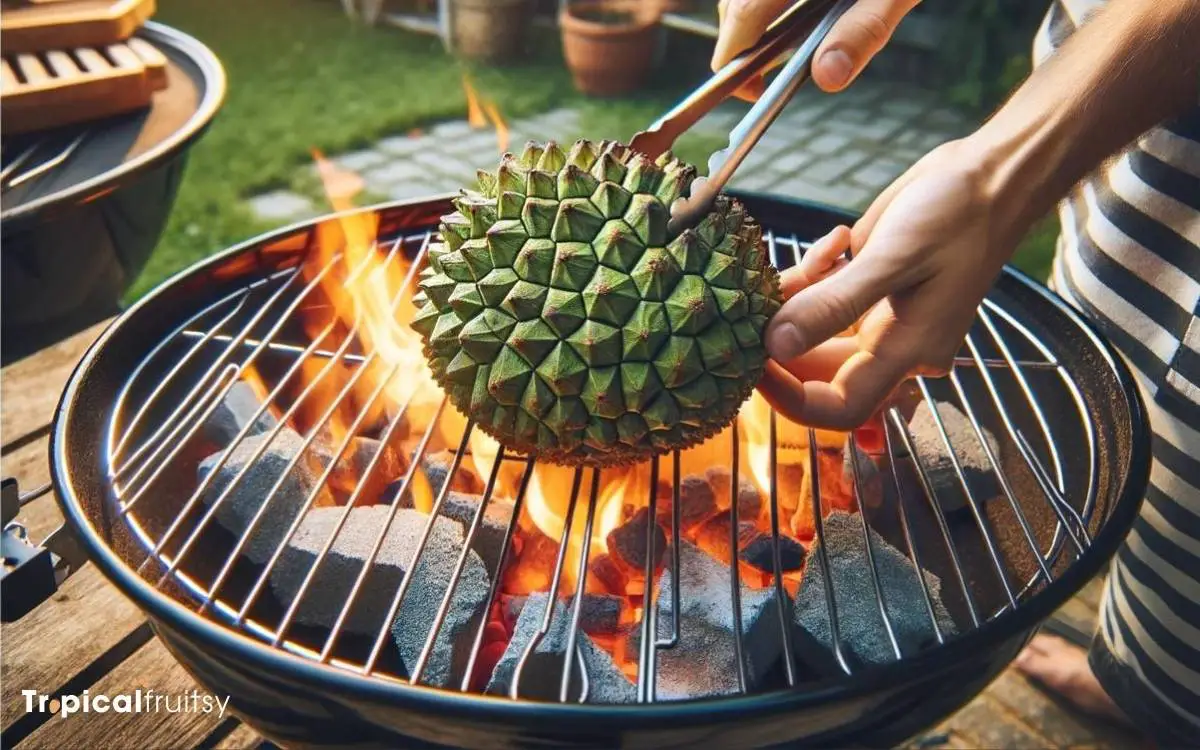
Key Takeaway
Step 1: Selecting the Perfect Breadfruit

Before attempting to roast breadfruit on a grill, it is crucial to select a fruit that is at the ideal stage of ripeness for cooking.
A mature but firm breadfruit should exhibit a greenish-yellow hue, with little to no brown patches or blemishes, signaling it has reached the optimal ripeness without crossing into overripeness.
The skin of the perfect candidate for roasting should yield slightly under gentle pressure, indicating the interior starches have begun to convert to sugars, which will caramelize and enhance the flavor during the roasting process.
Additionally, the chosen breadfruit should be heavy for its size, a sign of its freshness and water content, which will contribute to a moist, tender texture upon being roasted.
Step 2: Preparing the Breadfruit
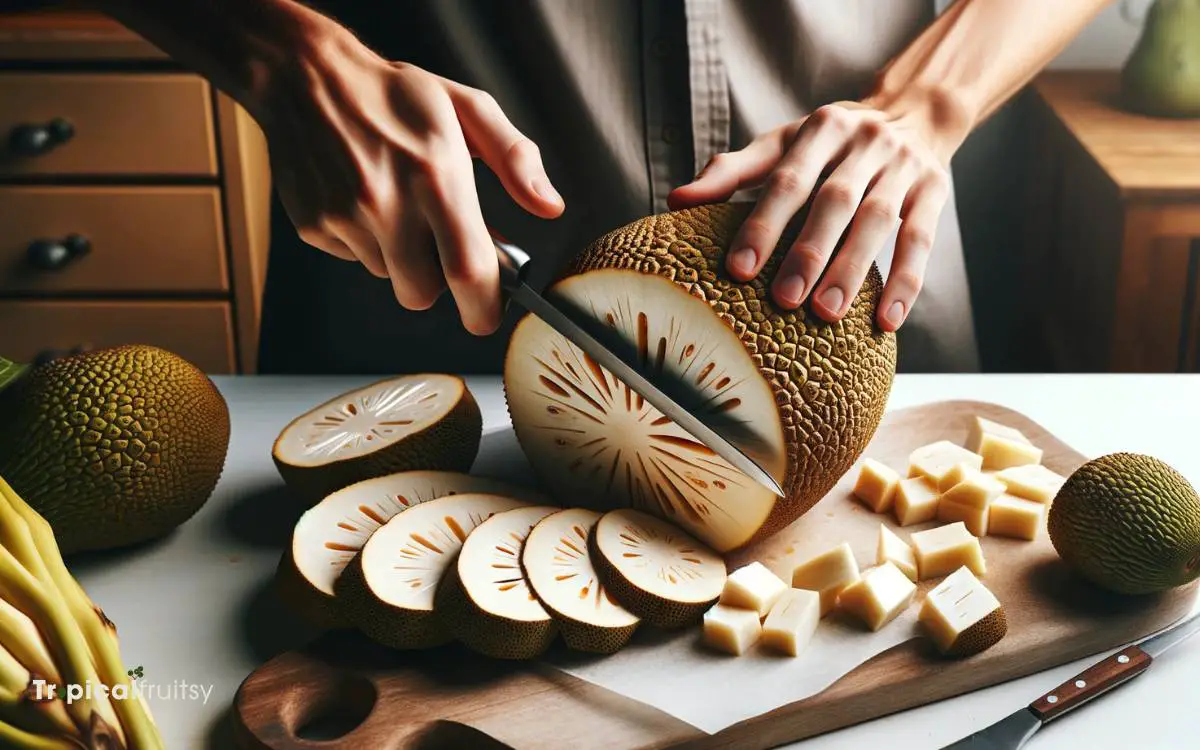
Once you have chosen a suitable breadfruit, wash its exterior thoroughly to remove any dirt or debris before proceeding to the next steps of preparation.
The meticulous cleansing of the fruit is crucial as it ensures that no impurities will mar the flavor or texture of the roasted breadfruit.
Here is a concise guide to prepping your breadfruit for the grill:
- Trim off the stem and blossom ends, creating flat surfaces that will stabilize the breadfruit during roasting.
- Score the skin in a shallow, crisscross pattern. This technique allows heat to penetrate evenly and facilitates easier peeling post-roasting.
- Lightly coat the entire surface with oil, which not only prevents sticking but also imbues the breadfruit with a subtle richness as it grills to perfection.
This methodical approach will set the stage for a delectable culinary experience.
Step 3: Preheating Your Grill

To ensure optimal roasting conditions, one must preheat the grill to a medium-high temperature, typically between 350°F to 400°F (175°C to 205°C). This step is crucial for achieving a uniformly cooked breadfruit with a desirable charred exterior.
Begin by cleaning your grill grates to assure an uncontaminated cooking surface, which aids in the prevention of sticking and ensures even heat distribution.
After cleaning, ignite your grill and set it to the specified temperature range. Allow it to warm for approximately 10 to 15 minutes.
A preheated grill ensures that the breadfruit begins to cook as soon as it comes into contact with the grates, sealing in flavors and imparting a smoky essence.
With the grill adequately heated, the preparation for roasting can proceed to the next critical phase: applying oil and seasonings to the breadfruit.
Step 4: Applying Oil and Seasonings
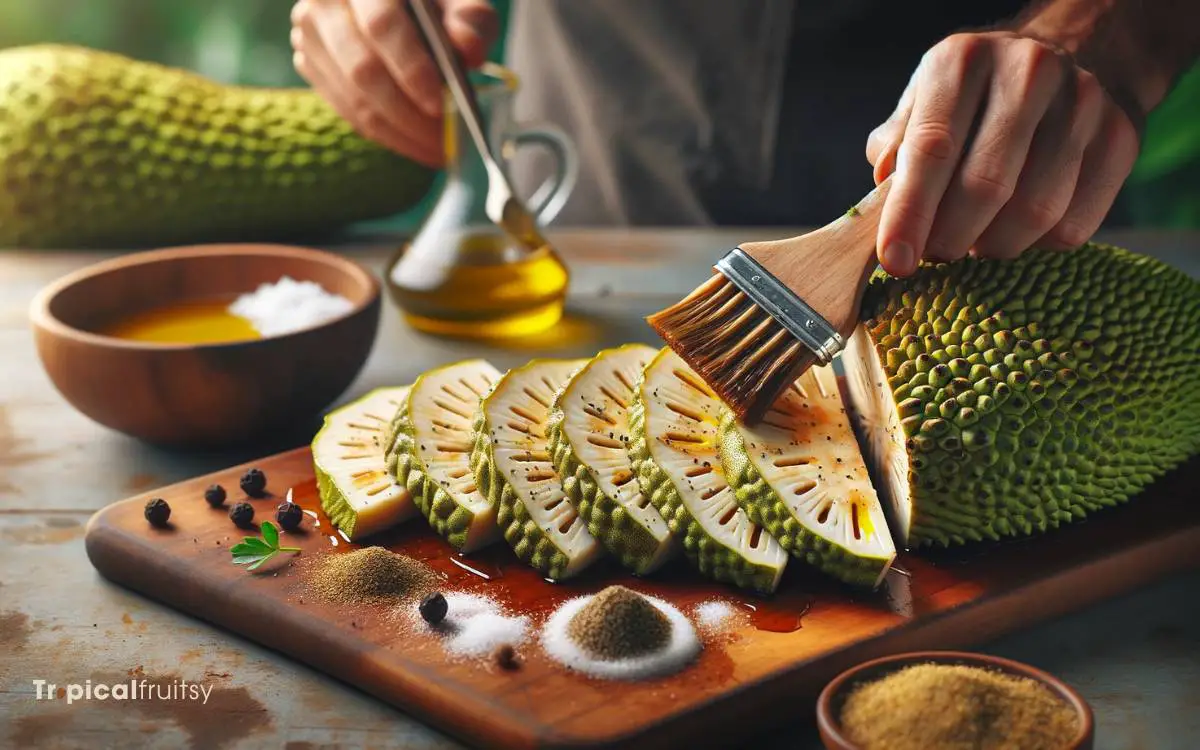
After preheating the grill, coat the breadfruit with a thin layer of oil and sprinkle your chosen seasonings evenly over its surface.
This process is not merely a preparation step but a rite that transforms the humble breadfruit into a culinary delight.
To ensure the breadfruit absorbs the full spectrum of flavors and attains a desirable texture, follow these meticulously curated instructions:
- Select a high-smoke point oil such as canola or avocado oil, which will form a protective barrier, preventing the breadfruit from drying out.
- Choose seasonings that complement the breadfruit’s subtle sweetness; sea salt, black pepper, and a hint of garlic powder are excellent starters.
- Gently massage the oil and seasonings into the breadfruit’s scored flesh, guaranteeing an even distribution and deep penetration of flavors.
Approach this step with care and intention, knowing that it sets the stage for a perfectly roasted breadfruit.
Step 5: Grilling the Breadfruit
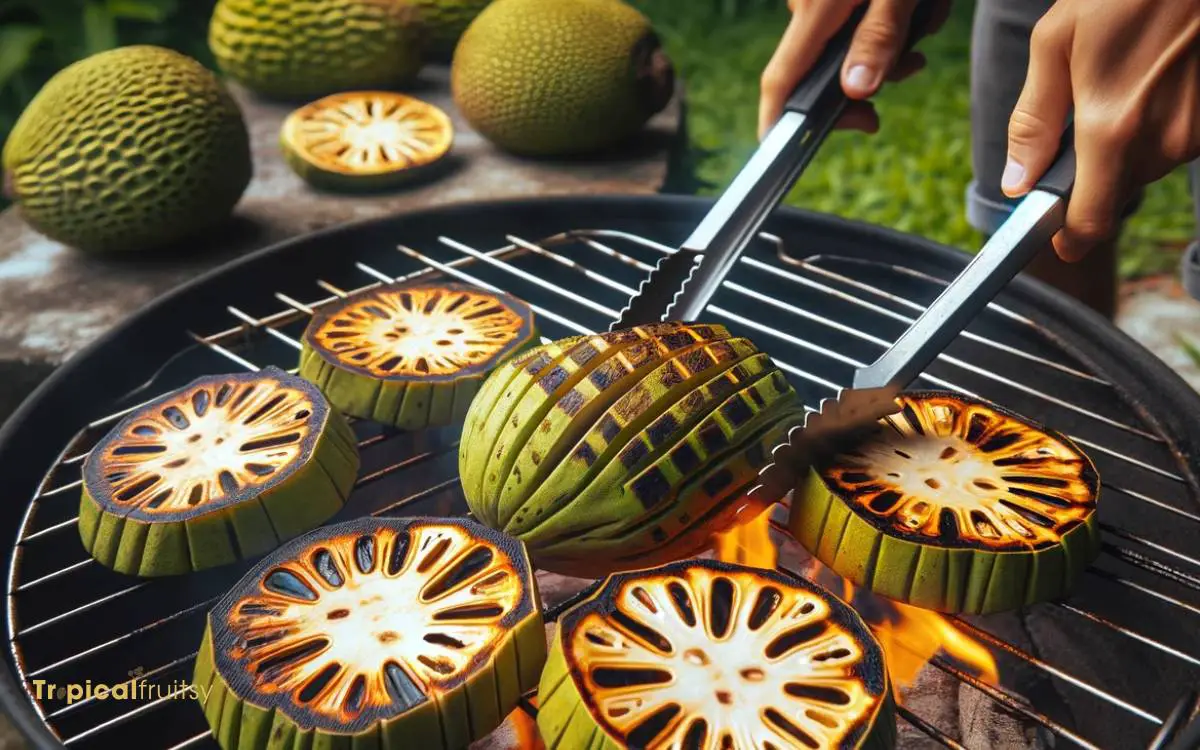
Place the seasoned breadfruit directly on the grill over medium heat to begin the roasting process.
The optimal temperature for grilling breadfruit is between 350°F to 400°F, which allows for a steady cooking process without charring the exterior too quickly.
Carefully monitor the breadfruit as it roasts, turning it intermittently to ensure even cooking and to prevent any side from burning.
The skin should become slightly charred and the flesh tender, which typically takes about 30 to 45 minutes depending on the size and ripeness of the breadfruit.
To test for doneness, insert a skewer or fork into the thickest part of the breadfruit; it should penetrate easily with little resistance.
Once fully cooked, remove the breadfruit from the grill and let it rest for a few minutes before serving.
Step 6: Checking for Doneness
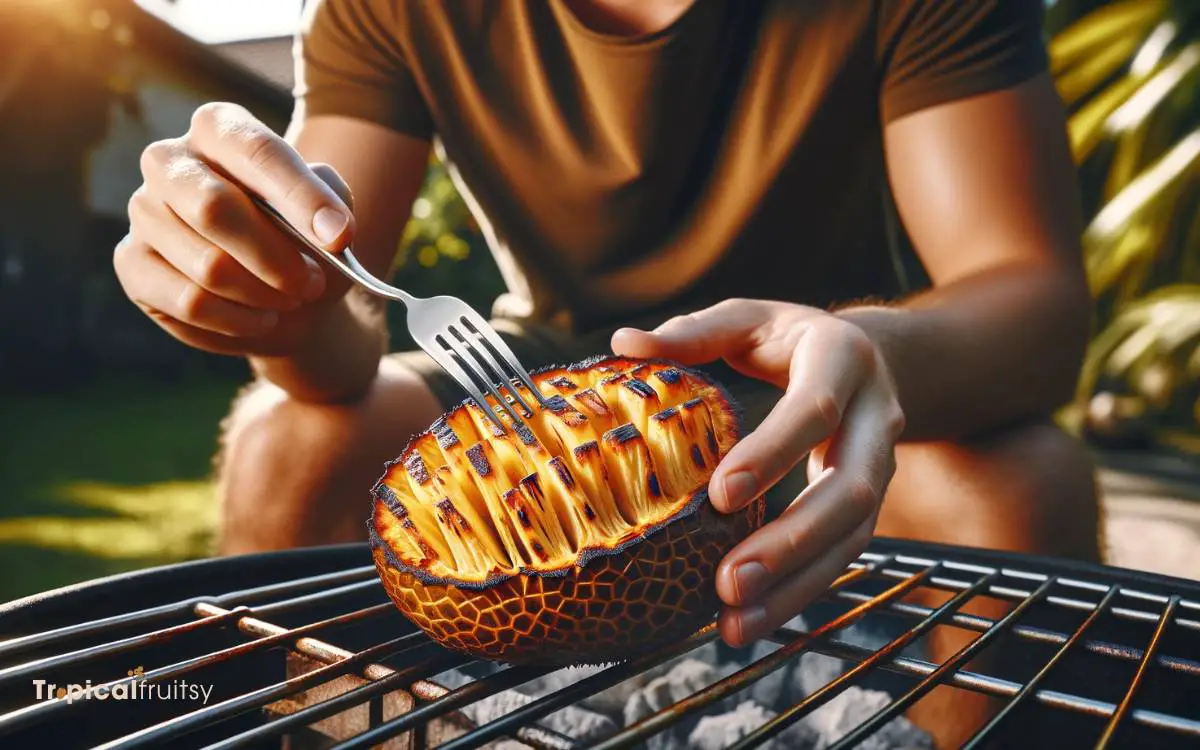
Ascertaining the readiness of roasted breadfruit involves a combination of visual, tactile, and olfactory assessments.
A notable darkening of the skin indicates a transformation indicative of internal cooking, while the resistance offered by the flesh upon gentle pressure suggests the desired textural outcome.
Furthermore, the emanation of a rich, sweet aroma serves as a culinary herald of the breadfruit’s roasting completion.
Skin Color Change
Several indicators, including a distinct change in skin color from green to a yellowish-brown, signal that the breadfruit is approaching doneness on the grill.
As the breadfruit roasts, the skin undergoes a transformation that not only reflects a change in physical appearance but also signifies a deeper metamorphosis in flavor and texture. Observing this color shift is critical for achieving the perfect roast.
- Anticipation: As the breadfruit slowly turns a golden hue, the anticipation of savoring its rich, smoky flavor heightens.
- Satisfaction: Witnessing the breadfruit’s skin reach the ideal shade of yellowish-brown brings a sense of culinary achievement.
- Readiness: The color change is a visual cue to chefs that the breadfruit is ready to be removed from the heat and enjoyed.
Flesh Firmness Test
A breadfruit’s readiness for consumption can further be assessed by performing a flesh firmness test, which involves gently pressing the outer skin to feel for a soft, yielding texture indicative of proper doneness.
To conduct this test methodically, remove the breadfruit from the heat source using appropriate protective equipment to avoid burns. Allow it to rest briefly to stabilize the internal temperature.
Then, with a cautious application of pressure using your fingertips, probe various sections of the breadfruit.
A uniformly tender feel suggests that the heat has permeated through the flesh, breaking down the starches sufficiently. Conversely, resistance or hardness may indicate the need for additional cooking time.
Ensure that this assessment is performed evenly around the entire fruit to confirm consistent readiness.
Aromatic Cues
In addition to tactile feedback, the release of a distinct, sweet aroma from the breadfruit serves as a reliable indicator that it has reached the desired level of doneness on the grill.
As the sugars within the fruit caramelize, a rich bouquet of fragrances signals that your breadfruit is nearing perfection.
The olfactory cues are not merely an alert to readiness; they also enhance the overall sensory experience of the roasting process.
- The Sweetness of Success: As the sugars break down, the sweet scent intensifies, indicating a well-roasted fruit.
- A Hint of Smokiness: A subtle smoky fragrance implies a delightful char that adds complexity to the flavor.
- The Warmth of Caramel: The caramelizing scent suggests a golden-brown, crispy exterior, promising a satisfying texture.
These aromatic cues, methodically observed, guide the griller to achieve the optimum culinary outcome.
Is Roasting Breadfruit on an Open Fire Different from Roasting it on a Grill?
Roasting breadfruit on an open fire gives it a smokier flavor compared to roasting it on a grill. The direct contact with the flames imparts a distinct charred taste that is unique to cooking over an open fire. Roast breadfruit on open fire for an authentic outdoor cooking experience.
Serving Suggestions
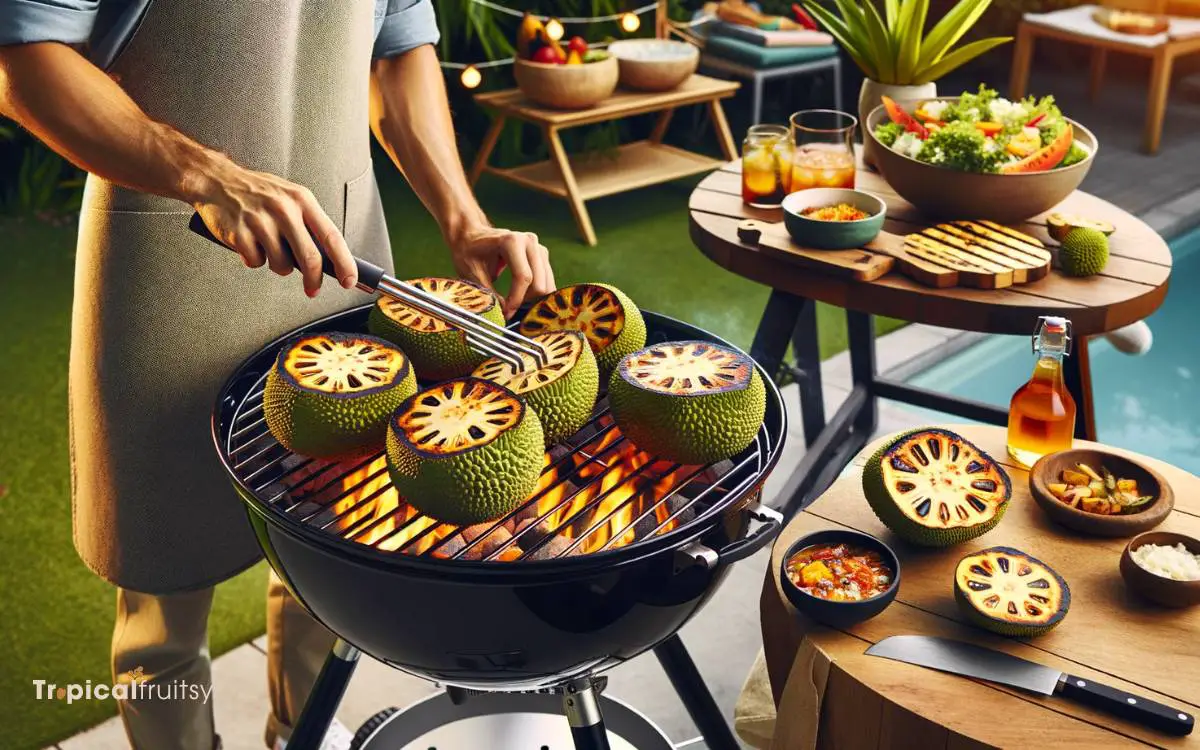
Roasted breadfruit can be served as a versatile side dish, complementing a variety of proteins such as grilled chicken, fish, or tofu. Its starchy texture and subtle sweetness make it an excellent canvas for bold flavors.
For a balanced meal, consider pairing the roasted breadfruit with a spicy jerk seasoning or a tangy vinaigrette to enhance its natural taste.
The breadfruit’s firm structure holds up well to a myriad of culinary applications, from being mashed like potatoes for a tropical spin on a classic to being cubed and added to a robust salad.
When plated, its golden-brown exterior offers a visually appealing contrast that is sure to entice diners.
Conclusion
The process of grilling breadfruit encompasses a series of methodical steps, from selecting a ripe specimen to serving it with complementary flavors. When executed proficiently, the result is a delectably charred and nutritious dish.
Considering that breadfruit trees can yield up to 200 fruits per year, this method of preparation provides a sustainable and innovative culinary approach to incorporating this underutilized tropical staple into diverse diets globally, enhancing both food security and gastronomic variety.






